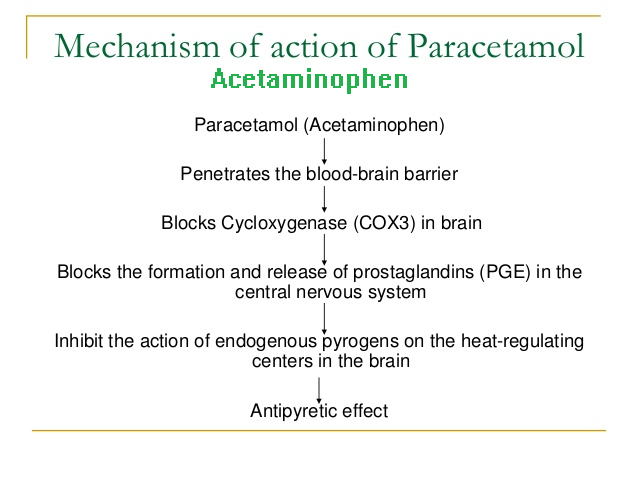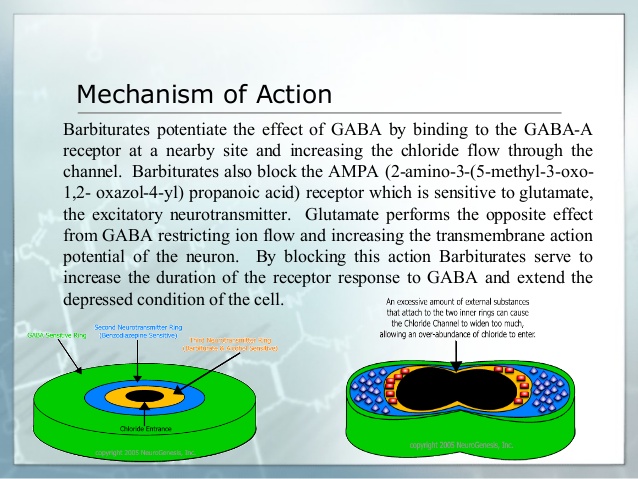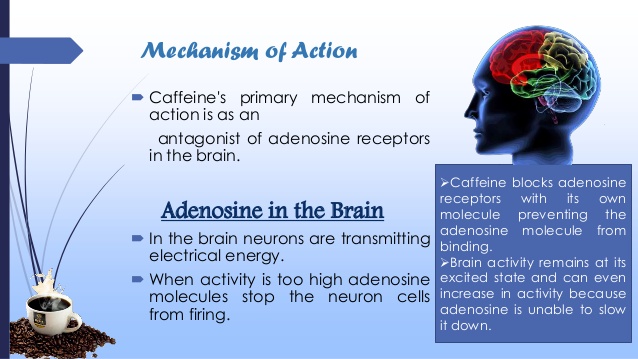The roles and interactions of the combination of acetaminophen, butalbital and caffeine in the treatment of tension headaches are not well understood. But the different mechanisms of action of acetaminophen, or butalbital, or caffeine are well understood.
The mechanism of action of acetaminophen
 Acetaminophen: Acetaminophen acts primarily in the CNS and increases the pain threshold by inhibiting cyclooxygenase, an enzyme involved in prostaglandin (PG) synthesis. Paracetamol (acetaminophen) is generally considered to be a weak inhibitor of the synthesis of prostaglandins (PGs). However, the in vivo effects of paracetamol are similar to those of the selective cyclooxygenase-2 (COX-2) inhibitors. Paracetamol also decreases PG concentrations in vivo, but, unlike the selective COX-2 inhibitors, paracetamol does not suppress the inflammation of rheumatoid arthritis. Acetaminophen inhibits both isoforms of central cyclooxygenase, COX-1 and COX-2.
Acetaminophen: Acetaminophen acts primarily in the CNS and increases the pain threshold by inhibiting cyclooxygenase, an enzyme involved in prostaglandin (PG) synthesis. Paracetamol (acetaminophen) is generally considered to be a weak inhibitor of the synthesis of prostaglandins (PGs). However, the in vivo effects of paracetamol are similar to those of the selective cyclooxygenase-2 (COX-2) inhibitors. Paracetamol also decreases PG concentrations in vivo, but, unlike the selective COX-2 inhibitors, paracetamol does not suppress the inflammation of rheumatoid arthritis. Acetaminophen inhibits both isoforms of central cyclooxygenase, COX-1 and COX-2.
Acetaminophen does not inhibit PG synthesis in peripheral tissues, which is the reason for its lack of peripheral anti-inflammatory effects. The antipyretic activity of acetaminophen is exerted by blocking the effects of endogenous pyrogen on the hypothalamic heat-regulating center by inhibiting PG synthesis. Heat is dissipated by vasodilatation, increased peripheral blood flow, and sweating.
The mechanism of action of butalbital
Butalbital (5-allyl-5-isobutylbarbituric acid), a slightly bitter, white, odorless, crystalline powder, is a short to intermediate-acting barbiturate. The mechanism of action of barbiturate is listed below:

Butalbital: Butalbital has generalized depressant effect on central nervous system and, in very high doses, has peripheral effects. Sedative-hypnotic effects of butalbital are similar to phenobarbital and may result from producing or enhancing the inhibitory affects of gamma-aminobutyric acid (GABA) in the thalamus. Barbiturates inhibit ascending conduction in the reticular formation, which interferes with conduction of impulses to the cortex causing sensory cortex depression, decreased motor activity, drowsiness, sedation and changes in cerebral function. Barbiturates also cause a nonselective depressant effect throughout the CNS and are capable of producing all types of CNS mood alterations. In addition, butalbital may exhibit anticonvulsant affects in high, anesthetic doses.
The mechanism of action of Caffeine

Caffeine is thought to produce constriction of cerebral blood vessels and serves to counteract the sedative effect of butalbital. Caffeine causes cerebral vasoconstriction, which decreases blood flow and oxygen tension. In combination with acetaminophen, caffeine may provide a quicker onset of action and enhance pain relief allowing for lower doses of analgesics. In some patients, caffeine relieves headaches by treating the effects of caffeine withdrawal.
Butalbital has a half-life of about 35 hours. Acetaminophen has a half-life of about 1.25 to 3 hours, but may be increased by liver damage and after an overdose. Caffeine has a half-life of about 2.5 to 4.5 hours.